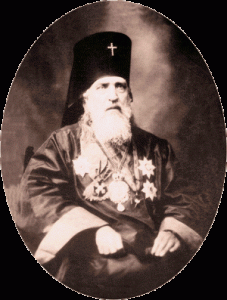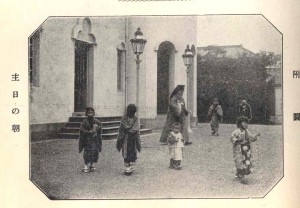 Before Christ ascended into heaven he told his disciples “Go therefore and make disciples of all nations, baptizing them in the name of the Father and of the Son and of the Holy Spirit, teaching them to observe all that I have commanded you; and lo, I am with you always, to the close of the age.” (Mt 28:19-20) In other words, Christ is calling his disciples (and us) to be missionaries, so the church was a missionary church right from the start. In the Book of Acts we see St. Peter and St. Paul and others beginning to spread the Gospel. Missionary activity continued after the death of the twelve apostles, despite the persecution of the Roman emperor. After the emperor accepted Christianity the church sent missionaries beyond the bounds of the Empire, such as St. Augustine to the British and Ss. Cyril and Methodius to the Slavs. After the fall of Constantinople the Ottoman Turks, the Greek Orthodox Church was in no position to send out missionaries – it had to struggle to even survive. However, the Russian Orthodox Church took on the task of mission, sending missionaries throughout the vast Russian Empire and beyond to China, Japan and Korea. One of these missionaries was St. Nicholas, Equal to the Apostles and Enlightener of Japan.
Before Christ ascended into heaven he told his disciples “Go therefore and make disciples of all nations, baptizing them in the name of the Father and of the Son and of the Holy Spirit, teaching them to observe all that I have commanded you; and lo, I am with you always, to the close of the age.” (Mt 28:19-20) In other words, Christ is calling his disciples (and us) to be missionaries, so the church was a missionary church right from the start. In the Book of Acts we see St. Peter and St. Paul and others beginning to spread the Gospel. Missionary activity continued after the death of the twelve apostles, despite the persecution of the Roman emperor. After the emperor accepted Christianity the church sent missionaries beyond the bounds of the Empire, such as St. Augustine to the British and Ss. Cyril and Methodius to the Slavs. After the fall of Constantinople the Ottoman Turks, the Greek Orthodox Church was in no position to send out missionaries – it had to struggle to even survive. However, the Russian Orthodox Church took on the task of mission, sending missionaries throughout the vast Russian Empire and beyond to China, Japan and Korea. One of these missionaries was St. Nicholas, Equal to the Apostles and Enlightener of Japan.
St. Nicholas (Ivan Dimitrievich Kasatkin) was born in 1836 in the family of a deacon. As a senior at the St. Petersburg Theological Academy in 1860 he saw a notice that a chaplain was needed at the Russian Consulate in Hakodate Japan. He applied and was accepted. After becoming a monk and being ordained a priest he began his year-long journey to Japan. During this time he met St. Innocent, a great missionary. St. Nicholas received valuable advice about how to be a good missionary. He arrived in Hakodate, Japan’s northernmost island in 1861.
Japan had just been opened to foreigners. Prior to this for 300 years, with few exceptions foreigners had been forbidden to enter Japan and Japanese had been forbidden to leave. Christianity was illegal and being a Christian was punishable by death. St. Nicholas began by studying Japanese and continued for seven years, becoming one of the few westerners to have mastered Japanese at that time.
While living at the consulate, a Japanese samurai (warrior), Sawabe Takuma, who was teaching Japanese swordsmanship to the consul general’s son, burst into St. Nicholas’ room threatening to kill him because this samurai hated Christianity. St. Nicholas, showing no fear, said that it was dishonorable to kill a man before one knew what he actually taught. The samurai agreed and St. Nicholas began to tell him about Christianity. This samurai became a regular visitor to St. Nicholas. Finally, Sawabe requested baptism. St. Nicholas baptized him with a few others, giving him the name Paul. This was all done in great secrecy because Christianity was still illegal in Japan.
In 1871 St. Nicholas moved to Tokyo. There he eventually opened several schools, including a seminary after Christianity became legal (Paul Sawabe became the first Japanese to become an Orthodox priest). St. Nicholas also built a great Cathedral, named after the Holy Resurrection. There, this cathedral, which still stands, is called by everyone as Nikorai-do, or Nicholas’ Cathedral, because it was so associated with St. Nicholas. St. Nicholas was a tireless traveler, visiting many areas in Japan, opening churches, which he filled with Japanese priests. He was a tireless translator, spending many hours each day translating the services and Bible into Japanese. In 1904 when war began between Russian and Japan, St. Nicholas was the only Russian who remained in Japan. As a good shepherd he did not want to leave his flock. St. Nicholas did a great deal to help Russian prisoners of war in Japan, and received awards from the Russian and Japanese emperors. St. Nicholas died in 1912 and left behind a church of 33,000 believers, 32 priests, 96 churches and 265 chapels, overcoming difficulties associated with the Russian Revolution and WWII, the Japanese church continues as an autonomous church within the Moscow Patriarchate. The Metropolitan and the great majority of clergy are Japanese.
There, this cathedral, which still stands, is called by everyone as Nikorai-do, or Nicholas’ Cathedral, because it was so associated with St. Nicholas. St. Nicholas was a tireless traveler, visiting many areas in Japan, opening churches, which he filled with Japanese priests. He was a tireless translator, spending many hours each day translating the services and Bible into Japanese. In 1904 when war began between Russian and Japan, St. Nicholas was the only Russian who remained in Japan. As a good shepherd he did not want to leave his flock. St. Nicholas did a great deal to help Russian prisoners of war in Japan, and received awards from the Russian and Japanese emperors. St. Nicholas died in 1912 and left behind a church of 33,000 believers, 32 priests, 96 churches and 265 chapels, overcoming difficulties associated with the Russian Revolution and WWII, the Japanese church continues as an autonomous church within the Moscow Patriarchate. The Metropolitan and the great majority of clergy are Japanese.
St. Nicholas was obviously a great missionary in the tradition of Ss. Cyril and Methodius, St. Innocent of Alaska and St. Macarius of the Altai. It is clear that St. Nicholas intended to found a native Japanese church. He began preparing a native clergy and translating the service books into Japanese from the earliest days of his ministry. His success is shown in the way the Japanese Orthodox Church survived the Russian Revolution, when all support from Russian was cut off and the difficulties of the Second World War. We can learn from St. Nicholas that even in the most difficult of circumstances it is still possible to proclaim the Gospel.
Fr. John
